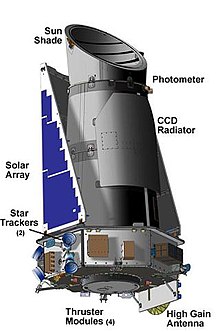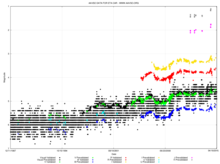
Apparent magnitude is a measure of the brightness of a star or other astronomical object. An object's apparent magnitude depends on its intrinsic luminosity, its distance, and any extinction of the object's light caused by interstellar dust along the line of sight to the observer.
Photometric-standard stars are a series of stars that have had their light output in various passbands of photometric system measured very carefully. Other objects can be observed using CCD cameras or photoelectric photometers connected to a telescope, and the flux, or amount of light received, can be compared to a photometric-standard star to determine the exact brightness, or stellar magnitude, of the object.

Observational astronomy is a division of astronomy that is concerned with recording data about the observable universe, in contrast with theoretical astronomy, which is mainly concerned with calculating the measurable implications of physical models. It is the practice and study of observing celestial objects with the use of telescopes and other astronomical instruments.
Joel Stebbins was an American astronomer who pioneered photoelectric photometry in astronomy. He was director of the University of Illinois Observatory from 1903 to 1922 where he performed innovative work with the selenium cell. In 1922 he became director of the Washburn Observatory at the University of Wisconsin–Madison where he remained until 1948. After 1948, Stebbins continued his research at Lick Observatory until his final retirement in 1958.

Gaia is a space observatory of the European Space Agency (ESA), launched in 2013 and expected to operate until 2025. The spacecraft is designed for astrometry: measuring the positions, distances and motions of stars with unprecedented precision, and the positions of exoplanets by measuring attributes about the stars they orbit such as their apparent magnitude and color. The mission aims to construct by far the largest and most precise 3D space catalog ever made, totalling approximately 1 billion astronomical objects, mainly stars, but also planets, comets, asteroids and quasars, among others.

The High Speed Photometer (HSP) is a scientific instrument formerly installed on the Hubble Space Telescope. The HSP was designed to measure the brightness and polarity of rapidly varying celestial objects. It could observe in ultraviolet, visible light, and near infrared at a rate of one measurement per 10 microseconds. The design was novel in that despite being able to view through a variety of filters and apertures, it had no moving parts "except for electrons" as principal investigator Prof. Robert Bless was fond of saying. Filter and aperture selection was accomplished using image dissector tubes and the HST pointing system. It was functional from launch in 1990 until it was removed at the end of 1993, and it helped diagnose an issue with the Hubble's primary mirror.
In astronomy, surface brightness (SB) quantifies the apparent brightness or flux density per unit angular area of a spatially extended object such as a galaxy or nebula, or of the night sky background. An object's surface brightness depends on its surface luminosity density, i.e., its luminosity emitted per unit surface area. In visible and infrared astronomy, surface brightness is often quoted on a magnitude scale, in magnitudes per square arcsecond (MPSAS) in a particular filter band or photometric system.
The Astronomical Observatory of Belogradchik or Belogradchik Observatory is an astronomical observatory owned and operated by the Institute of Astronomy of the Bulgarian Academy of Sciences. It is located near the town of Belogradchik in northwestern Bulgaria, at the foot of the Western Balkan Mountains. The other observatory operated by the same institute is the Rozhen Observatory.

In astronomy, magnitude is measure of the brightness of an object, usually in a defined passband. An imprecise but systematic determination of the magnitude of objects was introduced in ancient times by Hipparchus.
Psi Tauri, which is Latinized from ψ Tauri, is a solitary star in the zodiac constellation of Taurus. It has a yellow-white hue and is visible to the naked eye with an apparent visual magnitude of +5.22. The distance to this system, as determined using an annual parallax shift of 36.2 mas as seen from the Earth, is 90 light years. It is drifting further away with a radial velocity of +9 km/s.

Iota Trianguli Australis is a binary star system in the constellation Triangulum Australe. It is visible to the naked eye with a combined apparent visual magnitude of +5.27. Based upon an annual parallax shift of 25.77 mas as seen from the Earth, it is located around 127 light years from the Sun. The system appears to be moving closer to the Sun with a radial velocity of around −6 km/s.
Photographic magnitude is a measure of the relative brightness of a star or other astronomical object as imaged on a photographic film emulsion with a camera attached to a telescope. An object's apparent photographic magnitude depends on its intrinsic luminosity, its distance and any extinction of light by interstellar matter existing along the line of sight to the observer.

SkyMapper is a fully automated 1.35 m (4.4 ft) wide-angle optical telescope at Siding Spring Observatory in northern New South Wales, Australia. It is one of the telescopes of the Research School of Astronomy and Astrophysics of the Australian National University (ANU). The telescope has a compact modified Cassegrain design with a large 0.69 m secondary mirror, which gives it a very wide field of view: its single, dedicated instrument, a 268-million pixel imaging camera, can photograph 5.7 square degrees of sky. The camera has six light filters which span from ultraviolet to near infrared wavelengths.
In astronomy, a photometric system is a set of well-defined passbands, with a known sensitivity to incident radiation. The sensitivity usually depends on the optical system, detectors and filters used. For each photometric system a set of primary standard stars is provided.

The UBV photometric system, also called the Johnson system, is a photometric system usually employed for classifying stars according to their colors. It was the first standardized photometric system. The apparent magnitudes of stars in the system are often used to determine the color indices B−V and U−B, the difference between the B and V magnitudes and the U and B magnitudes respectively.
The Strömgren photometric system, abbreviated also as uvbyβ or simply uvby, and sometimes referred as Strömgren - Crawford photometric system, is a four-colour medium-passband photometric system plus Hβ (H-beta) filters for determining magnitudes and obtaining spectral classification of stars. Its use was pioneered by the Danish astronomer Bengt Strömgren in 1956 and was extended by his colleague the American astronomer David L. Crawford in 1958.

The University of Illinois Astronomical Observatory, located at 901 S. Mathews Avenue in Urbana, Illinois, on the campus of the University of Illinois Urbana–Champaign, was built in 1896, and was designed by Charles A. Gunn. It was listed on the National Register of Historic Places on November 6, 1986, and on December 20, 1989, was designated a National Historic Landmark.
A photometric redshift is an estimate for the recession velocity of an astronomical object such as a galaxy or quasar, made without measuring its spectrum. The technique uses photometry to determine the redshift, and hence, through Hubble's law, the distance, of the observed object.
Gerald Kron was an American astronomer who was one of the pioneers of high-precision photometry with photoelectric instrumentation. He discovered the first starspot and made the first photometric observation of a stellar flare.











